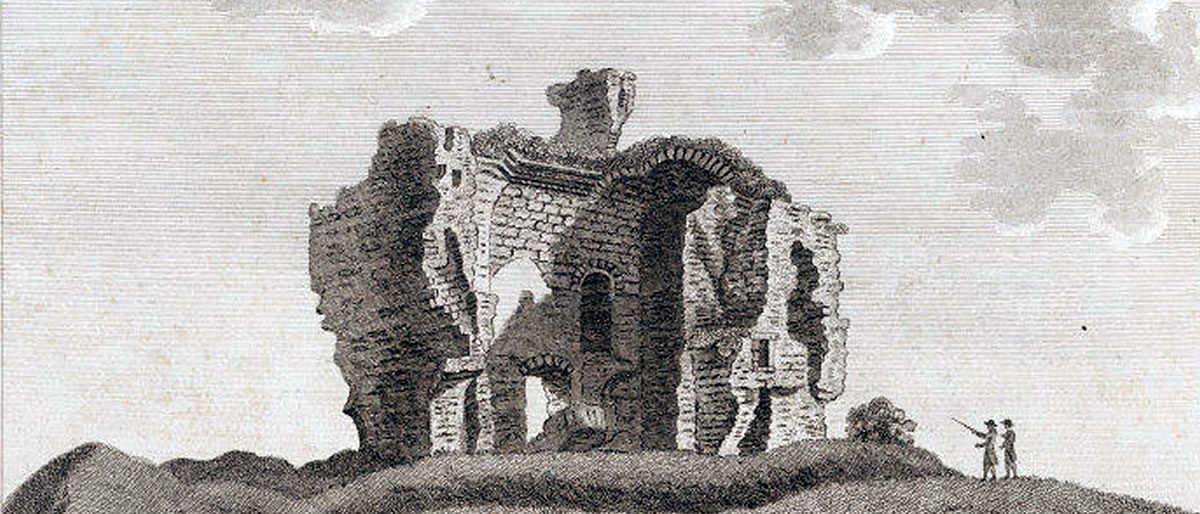From ‘Transactions of the Dumfriesshire & Galloway Natural History and Antiquarian Society’ 1993
(NY033782) by A.M.T. Maxwell – Irving
Scan of the Original Document (with footnotes & references)
Early History | The Site | The Tower | Later History
Early History
The earliest known possessors ot the lands of Torthorwald were the family ‘de Torthorwald’ who took their name from the place. They were evidently a family of some consequence, and it was presumably they who raised the first motte and bailey, castle on the site some time during the 12th century. lt is from this period that the extensive eartworks surrounding the site would seem largely to date, although the name Torthorwald meaning “hill of Thorold“,’ suggests that they may well incorporate earthworks of an even earlier, pre-mediaeval settlement.
David de Torthorwald was a witness to a Bruce charter c. 1218 and around the same date Bruce confirmed to David that no fine for straying animals would be extracted within the barony of Annandale and the tenement of Torthorwald except 1d for 10 cattle, 1d for 10 sheep etc.
Some of the family later supported the English during the Wars of Independence and forfeited their lands. It was presumably then that bruce granted the barony of Torthorwald to Sir John de Soulis, although the de Soulis did not long enjoy the property before they to suffered forfeiture.
Another of the family was sir David de Torthorwald who swore fealty to Edward 1 in 1291. On his death in 1296 he was succeeded by his only daughter, Isobel, who, according to some accounts, is said to have married Sir Humphrey de Kirkpatrick, eldest son and heir of Sir Roger Kirkpatrick of that Ilk.
it was to this Sir Humphrey in 1321 that Bruce granted the whole lands and town of Totthorwald, with the 3 husbandland of roucan, in free warren as a reward for his services and in part compensation for the destruction of Auchencass, the familys former stronghold. This grant was confirmed in 1326. Thereafter Humphrey and his successors were designated ‘of Torthorwald’ which presumably became their new seat.
When Edward Balliol invaded Scotland in 1332, Humphrey and his wife fled with his parents to England. They returned some time later. but in 1357 Humphrey returned to
England again as a hostage for the release of Davidl II. and there he died.
He was succeeded in Torthorwald by Roger Kirkpatrick, who is thought to have been his younger brother.
Roger’s tenure was very brief, for after taking Caerlaverock Castle and being appointed its captain, he was murdered there later the same year.
The next laird was Roger’s son Sir Duncan Kirkpatrick, who was granted a new infeftment in the barony of Torthorwald in 1398. Leaving no male issue his estates devolved upon his three daughters, the eldest of whom, Elizabeth, inherited Torthorwald while the next daughter Janet received part of the lands of Kirkpatrick with Auchencass.
Elizabeth Kirkpatrick married William Carlyle, son and heir of Sir John Carlyle, the representative of the ancient family of Carlyle from the city of that name. Elizabeth’s father died before June 1425, after which time William is designated ‘of Torthorwald’. In 1436 he agreed with Thomas Graham of Auchencass to exchange that part of the lands of Kirkpatrick that he had inherited through his late wife half the lands of Roucan, in the barony of Torthorwald, which Graham had inherited through his late wife, Janet Kirkpatrick, Elizabeth’s sister. By 1443 William had also aquired the lands of Kinmount. He died in 1463.
By this time the present castle of Torthorwald had been built, though who first built it. and when, is not known. As the ruins now stand they represent no less than four phases of building, the earliest of which undoubtedly dates from the 14th century. Cruden has suggested a date early in the century, pointing out that the masonry incorporates checked or rebated joints, a rare feature found elsewhere in SW Scotland at the castles of Lochmaben and Loch Doon. While Stell is inclined to a date somewhat later. A further problem is that the rebated joints referred to by Cruden belong. not to the first but to the second phase of building.
It is not until much later that the castle itself is first mentioned. Standing on at rocky outcrop, some 250 ft up the western slopes of the hills that divide Nithsdale from Annandale, it had a commanding view over the Lochar Moss and Lower Nithsdale to the S and W.
Early History | The Site | The Tower | Later History

